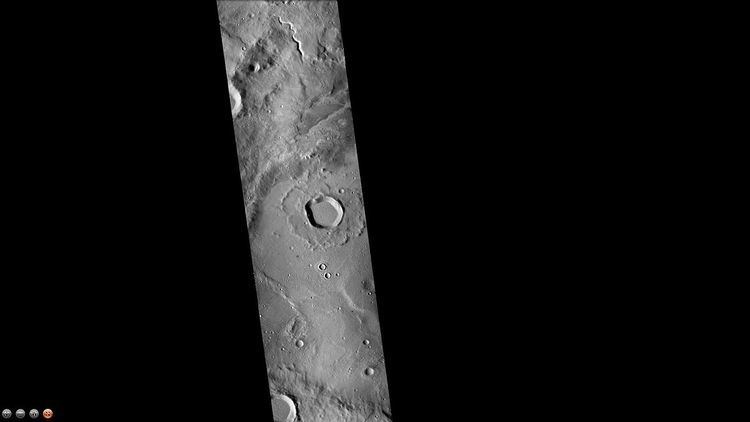 | ||
Flammarion is an impact crater in the Syrtis Major quadrangle on Mars at 22.4 ° N and 173.0 ° W. and is 173.0 km in diameter. Its name was approved in 1973, and it was named after Camille Flammarion. There may have been a lake in the crater in the past because a channel is visible on the rim in the picture below and layers are visible in one of the pictures.
Many places on Mars show rocks arranged in layers. Rock can form layers in a variety of ways. Volcanoes, wind, or water can produce layers. Sometimes the layers are of different colors. Light-toned rocks on Mars have been associated with hydrated minerals like sulfates. The Mars Rover Opportunity examined such layers close-up with several instruments. Some layers are probably made up of fine particles because they seem to break up into find dust. Other layers break up into large boulders so they are probably much harder. Basalt, a volcanic rock, is thought to in the layers that form boulders. Basalt has been identified on Mars in many places. Instruments on orbiting spacecraft have detected clay (also called phyllosilicate) in some layers. Recent research with an orbiting near-infrared spectrometer, which reveals the types of minerals present based on the wavelengths of light they absorb, found evidence of layers of both clay and sulfates in many places, especially craters. This is exactly what would appear if a large lake had slowly evaporated. Moreover, since some layers contain gypsum, a sulfate which forms in relatively fresh water, life could have formed in some craters.
Why craters are important
The density of impact craters is used to determine the surface ages of Mars and other solar system bodies. The older the surface, the more craters present. Crater shapes can reveal the presence of ground ice.
The area around craters may be rich in minerals. On Mars, heat from the impact melts ice in the ground. Water from the melting ice dissolves minerals, and then deposits them in cracks or faults that were produced with the impact. This process, called hydrothermal alteration, is a major way in which ore deposits are produced. The area around Martian craters may be rich in useful ores for the future colonization of Mars.
